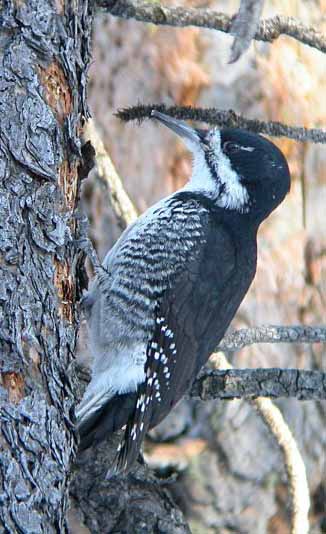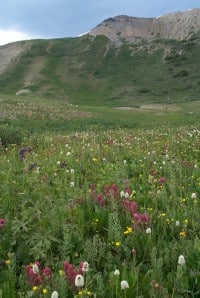The AP has the whole story, with highlighted snips below.
Four conservation groups filed a petition with the U.S. Interior Department on Wednesday to list the black-backed woodpecker under the Endangered Species Act in the Sierra Nevada, Oregon’s Eastern Cascades and the Black Hills of eastern Wyoming and western South Dakota.
In addition to fire suppression, the groups contend post-fire salvage logging combined with commercial thinning of green forests is eliminating what little remains of the bird’s habitat, mostly in national forests where it has no legal protection.
“Intensely burned forest habitat not only has no legal protection, but standard practice on private and public lands is to actively eliminate it,” the petition said. “When fire and insect outbreaks create excellent woodpecker habitat, salvage logging promptly destroys it.”
Chad Hanson, executive director the Earth Island’s John Muir Project based in Cedar Ridge, Calif., filed the petition Wednesday with the Interior Department’s U.S. Fish and Wildlife Service in Sacramento. Co-petitioners are the Center for Biological Diversity based in Tucson, Ariz., the Blue Mountains Biodiversity Project in Fossil, Ore., and the Biodiversity Conservation Alliance in Laramie, Wyo.
Hanson, a wildlife ecologist at the University of California, Davis, said the black-backed woodpecker has been eating beetles in fire-killed stands of conifer forests for millions of years and specifically in North American forests for “many thousand years — since the last Ice Age.”
“Now, it’s very rare,” he said. The best science suggests there are fewer than 1,000 pairs in Oregon and California, and fewer than 500 pairs in the Black Hills, the petition said.
“Such small populations are at significant risk of extinction, especially when their habitat is mostly unprotected and is currently under threat of destruction and degradation,” the document said.
Richard Hutto, a biology professor and director of the Avian Science Center at the University of Montana, has been doing post-fire research since the early 1990s. He said it would be difficult to find a forest-bird species more restricted to a single vegetation cover type than the black-backed woodpecker is to early post-fire conditions.
The California State Fish and Game Commission agreed in December to add the woodpecker to the list of species that are candidates for protection under the California Endangered Species Act. State Commissioner Michael Sutton said a two-year review of the bird’s status is warranted because some Forest Service plans allow “100 percent salvage logging of burned areas, which is the preferred habitat of this species.”
For more information about black-backed woodpeckers, their habitat needs and the ecology of recently burned forests, check out Listen to the Message of the Black-backed Woodpecker, a Hot Fire Specialist from the February 2009 issue of Fire Science Brief from the Joint Fire Science Program.
UPDATE: Here’s a copy of the petition and here’s the press release from the conservation groups.







